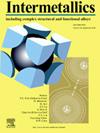Crystallochemistry, thermodynamic and physical properties of the intermetallic compound Cu3−x(As,Sb)
IF 4.3
2区 材料科学
Q2 CHEMISTRY, PHYSICAL
引用次数: 0
Abstract
During the investigation of the Cu-As-Sb ternary system, we identified the ternary intermetallic Cu3−x(As,Sb) compound. Its crystal structure was solved and refined by single crystal and powder X-ray diffraction. While the binary Cu3−xAs and Cu3−xSb phases crystallize in the hexagonal Cu3P-type (hP24, P63cm) and cubic anti-BiF3-type (cF16, Fmm), respectively, Cu3−x(As,Sb) adopts the cubic Cu6AsSb prototype (cP32, Pmn). Crystallochemical reasons lead to the exclusion that its structure could be of the UH3-type. Cu3−x(As,Sb) is isotypic with Cu12−xTeSb3; their crystal structure is a stuffed ternary derivative of the Cr3Si-type. SEM-EDX analyses reveal very large compositional ranges for this compound, mostly concerning the Sb/As ratio: 71.1−73.9 at.% Cu, 4.0−24.5 at.% As and 2.5−23.5 at.% Sb, corresponding to about Cu2.5-2.8As0.23-0.98Sb0.23-0.92 (x = 0.2−0.5). The lattice parameter and, consequently, the unit cell volume regularly expand while increasing the Sb/As compositional ratio: a ≈ 7.47 Å for Cu3−xAs0.75Sb0.25, a ≈ 7.65 Å for Cu3−xAs0.25Sb0.75 (averaged values).
Cu3−x(As,Sb) forms either by a peritectic reaction for As-rich compositions, or congruently for the equiatomic Sb/As and Sb-rich compositions. The decomposition- or melting-temperature values decrease as a function of the Sb/As compositional ratio [e.g. peritectic at 710 °C for Cu3−xAs0.75Sb0.25 (Cu72As21Sb7), congruent melting at 690 °C for Cu3−xAs0.50Sb0.50 (Cu72As14Sb14), and at 675 °C for Cu3−xAs0.25Sb0.75 (Cu72As7Sb21)].
Physical properties (electrical resistivity and magnetic susceptibility) indicate that Cu3−x(As,Sb) behaves as a good metal with electrical resistivity decreasing as the Sb/As compositional ratio increases; a peculiar anomaly in the electrical resistivity behavior (heavy-fermions like) was observed at low temperature, the origin of which needs further investigation. The compound is a standard diamagnet.
金属间化合物 Cu3-x(As,Sb)的晶体化学、热力学和物理特性
在研究铜-砷-锑三元体系的过程中,我们发现了三元金属间化合物 Cu3-x(As,Sb)。通过单晶和粉末 X 射线衍射,我们解决并完善了其晶体结构。二元 Cu3-xAs 和 Cu3-xSb 相分别结晶为六方 Cu3P 型(hP24, P63cm)和立方反 BiF3 型(cF16, Fm3¯m),而 Cu3-x(As,Sb) 则采用立方 Cu6AsSb 原型(cP32, Pm3‾n)。由于晶体化学的原因,排除了它可能是 UH3 型结构的可能性。Cu3-x(As,Sb)与 Cu12-xTeSb3 是同型物;它们的晶体结构是一种填充的 Cr3Si- 型三元衍生物。SEM-EDX 分析显示该化合物的成分范围非常大,主要涉及锑/砷比:71.1-73.9%的铜、4.0-24.5%的砷和 2.5-23.5% 的锑,相当于约 Cu2.5-2.8As0.23-0.98Sb0.23-0.92 (x = 0.2-0.5)。随着 Sb/As 成分比的增加,晶格参数以及单位晶胞体积有规律地扩大:Cu3-xAs0.75Sb0.25 的 a ≈ 7.47 Å,Cu3-xAs0.75Sb0.25 的 a ≈ 7.Cu3-x(As,Sb)在富含砷的成分中通过包晶反应形成,或在等原子 Sb/As 和富含锑的成分中通过共晶反应形成。分解温度或熔化温度值随 Sb/As 成分比的变化而降低[例如,Cu3-xAs0.75Sb0.25(Cu3-xAs0.75Sb0.25)在 710 °C 时发生包晶反应]。例如,Cu3-xAs0.75Sb0.25(Cu72As21Sb7)的包晶温度为 710 °C,Cu3-xAs0.50Sb0.50(Cu72As14Sb14)的同熔温度为 690 °C,Cu3-xAs0.25Sb0.75(Cu72As7Sb21)的同熔温度为 675 °C]。物理性质(电阻率和磁感应强度)表明,Cu3-x(As,Sb) 具有良好的金属特性,电阻率随着 Sb/As 成分比的增加而降低;在低温下,电阻率行为出现了异常(类似重铁氧体),其原因需要进一步研究。该化合物是一种标准二元磁体。
本文章由计算机程序翻译,如有差异,请以英文原文为准。
求助全文
约1分钟内获得全文
求助全文
来源期刊

Intermetallics
工程技术-材料科学:综合
CiteScore
7.80
自引率
9.10%
发文量
291
审稿时长
37 days
期刊介绍:
This journal is a platform for publishing innovative research and overviews for advancing our understanding of the structure, property, and functionality of complex metallic alloys, including intermetallics, metallic glasses, and high entropy alloys.
The journal reports the science and engineering of metallic materials in the following aspects:
Theories and experiments which address the relationship between property and structure in all length scales.
Physical modeling and numerical simulations which provide a comprehensive understanding of experimental observations.
Stimulated methodologies to characterize the structure and chemistry of materials that correlate the properties.
Technological applications resulting from the understanding of property-structure relationship in materials.
Novel and cutting-edge results warranting rapid communication.
The journal also publishes special issues on selected topics and overviews by invitation only.
 求助内容:
求助内容: 应助结果提醒方式:
应助结果提醒方式:


